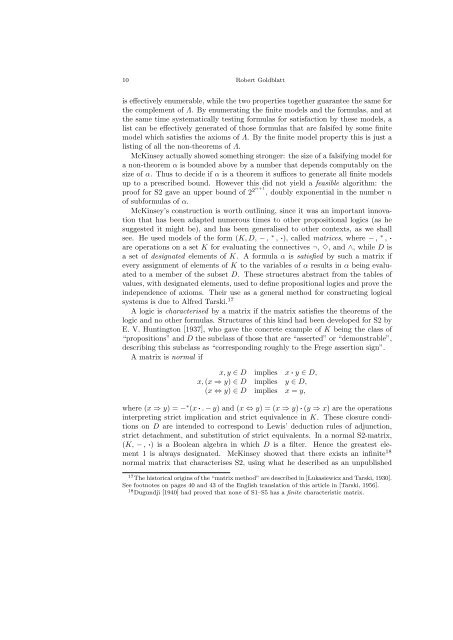MATHEMATICAL MODAL LOGIC: A VIEW OF ITS EVOLUTION
MATHEMATICAL MODAL LOGIC: A VIEW OF ITS EVOLUTION
MATHEMATICAL MODAL LOGIC: A VIEW OF ITS EVOLUTION
Create successful ePaper yourself
Turn your PDF publications into a flip-book with our unique Google optimized e-Paper software.
10 Robert Goldblattis effectively enumerable, while the two properties together guarantee the same forthe complement of Λ. By enumerating the finite models and the formulas, and atthe same time systematically testing formulas for satisfaction by these models, alist can be effectively generated of those formulas that are falsifed by some finitemodel which satisfies the axioms of Λ. By the finite model property this is just alisting of all the non-theorems of Λ.McKinsey actually showed something stronger: the size of a falsifying model fora non-theorem α is bounded above by a number that depends computably on thesize of α. Thus to decide if α is a theorem it suffices to generate all finite modelsup to a prescribed bound. However this did not yield a feasible algorithm: theproof for S2 gave an upper bound of 2 2n+1 , doubly exponential in the number nof subformulas of α.McKinsey’s construction is worth outlining, since it was an important innovationthat has been adapted numerous times to other propositional logics (as hesuggested it might be), and has been generalised to other contexts, as we shallsee. He used models of the form (K, D, − , ∗ , ·), called matrices, where − , ∗ , ·are operations on a set K for evaluating the connectives ¬, ✸, and ∧, while D isa set of designated elements of K. A formula α is satisfied by such a matrix ifevery assignment of elements of K to the variables of α results in α being evaluatedto a member of the subset D. These structures abstract from the tables ofvalues, with designated elements, used to define propositional logics and prove theindependence of axioms. Their use as a general method for constructing logicalsystems is due to Alfred Tarski. 17A logic is characterised by a matrix if the matrix satisfies the theorems of thelogic and no other formulas. Structures of this kind had been developed for S2 byE. V. Huntington [1937], who gave the concrete example of K being the class of“propositions” and D the subclass of those that are “asserted” or “demonstrable”,describing this subclass as “corresponding roughly to the Frege assertion sign”.A matrix is normal ifx, y ∈ D implies x · y ∈ D,x, (x ⇒ y) ∈ D implies y ∈ D,(x ⇔ y) ∈ D implies x = y,where (x ⇒ y) = − ∗ (x · . − y) and (x ⇔ y) = (x ⇒ y) · (y ⇒ x) are the operationsinterpreting strict implication and strict equivalence in K. These closure conditionson D are intended to correspond to Lewis’ deduction rules of adjunction,strict detachment, and substitution of strict equivalents. In a normal S2-matrix,(K, − , ·) is a Boolean algebra in which D is a filter. Hence the greatest element1 is always designated. McKinsey showed that there exists an infinite 18normal matrix that characterises S2, using what he described as an unpublished17 The historical origins of the “matrix method” are described in [̷Lukasiewicz and Tarski, 1930].See footnotes on pages 40 and 43 of the English translation of this article in [Tarski, 1956].18 Dugundji [1940] had proved that none of S1–S5 has a finite characteristic matrix.
















